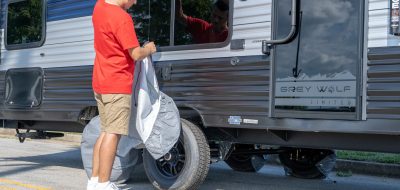Anyone who owns a pet probably has no trouble admitting that their four-legged friends (and birds and fish, too) are truly part of the family. And as such, their furry friends are entitled to all the perks and benefits of family membership, including travel.
Would you load up the RV for that trip to Yellowstone and leave your toddler at home? No, of course not, which is why so many travelers find ways (often times, a recreational vehicle) and the justification (Fido will miss us terribly) to accommodate their pets on the road. Ask the fellow in the next campsite with the iguana, Siamese cat and Schnauzer and I’ll bet he’ll tell you traveling with his menagerie was one of the prime reasons he opted for an RV in the first place. And who can blame him? The emotional bond between pets and their owners is well-documented. Studies have shown that the mere act of petting an animal lowers stress levels and blood pressure. It might be a medical necessity to have Fido join the traveling squad—doctor’s orders! Naturally, if we love something, we always want it near. You probably don’t need much more reason than that to bring your faithful friend(s) along for the ride. However, toting an animal in your home on wheels isn’t as easy as just packing a supply of catnip and keeping their water bowl filled. Just like your human family members, proper thought should be given to your animal’s environment, acclimation process and safety before departing on that maiden RV voyage. Here’s how to make the transition from home to RV as seamless as possible.
Preparation is Key
When all is said and done, pets want to be with their owners. Even if it requires an angst-ridden period of adjustment—and leaving their scratching post at home— most animals will gladly sacrifice a bit of their plush digs for quality time with the two-legged set. However, it’s still best to put pets at ease, which is why we recommend baby steps to get them ready for life in the RV. It took you some time to bond with the motorhome or trailer, so give them a similar grace period
Have the family pooch or kitty spend some time in the RV in the driveway before hitting the road. Start this a few days before the trip, gradually increasing the duration of time you both hang out inside. Cats are notoriously finicky about new settings, so let them take their sweet time. Remember, the more comfortable they are, the happier they (and you) will be, so don’t rush it.
Since all animals like to establish their turf, be sure to carve out their very own niche onboard, complete with bed, bowls, toys and litter box if they will use one in the RV. Let Fluffy hang out inside the RV while you are putting away groceries or gear inside. If you are there, your animal will more likely feel safe.
Your furry friend will probably want to explore the RV, with its many new smells and textures. They probably wouldn’t object to some treats thrown in for good measure or a new plaything or two. If you really want to expedite this touchy-feely phase, let them eat a few meals onboard. Like us, the fastest way to an animal’s heart is through their stomach.
When they’re starting to open up to the RV experience (a napping pet is a happy pet), up the ante by slowly introducing new sensations. The sound of the generator, the idle of the engine, the squeak that occurs when opening the roof vent. Just like my dog hates the vacuum cleaner—and balloons—it’s best to find out what irks them now rather than when you fire up the engine to leave or once you reach the campground. But ultimately, just let them settle in and relax at their own pace. You’ll know when they’re ready.
Maintain the Rules
Eventually, your pet will come to see the RV for what it is—just an extension of home. Will that lazy cat really need much explanation of how to use a trailer’s sofa, bed or chairs? We’re guessing instinct will take over and her 16-hour naps will resume as normal.
It’s for this reason that you should enforce the same home rules in your home-away-from-home in order to prevent confusion. If it’s forbidden for your pets to sleep on the furniture at home, then keep it consistent and don’t allow them to sleep on the furniture in the RV. If breakfast is served at 4:14 a.m. at home (like my dog’s), then maintain that schedule on the road. This should also keep your 150-pound German shepherd out of your bed—that is, unless he’s used to sleeping there. Again, normalcy is key, and you don’t want a confused animal running roughshod all over both the RV and home once you return from your trip.
Test Trip
Most pets, particularly dogs, will adapt to RV living quickly. In most cases, it’ll probably be little more than just turning on the ignition and going. However, some pets, particularly older animals, might not like it so much, which is why a practice trip is a good idea if you’re having doubts.
Spend a night at a local campground to let her get a feel for things. This is also a good time to practice leaving your pets inside the RV for short periods, say, 10-15 minutes or so. Many campgrounds that allow pets are fine with them alone in the RV provided they don’t make excessive noise. (Find out what the campground’s pet policies are before you arrive.)
Just what your pet’s reaction to your absence will be should be determined before embarking (no pun intended) on a longer trip. Separation anxiety may cause dogs to bark endlessly or tear up the place awaiting your return. Or she may be too unnerved by the animals prowling in the forest or the loud neighbors next door or the humming of the furnace to mellow out. If you find the RV experiment is failing, you’ll need to weigh your animal’s needs versus your wants. It might just be better for everyone to go the route of the kennel or pet-sitter while you’re away if your pet simply cannot adjust to RV life.
Leader of the Pack
Give your animals enough respect to spend adequate time packing their stuff. Fortunately, most travel pretty light and can put up with a lot in order to be near you. However, don’t skimp on their gear, especially easily forgotten items such as food, plastic bags (for picking up after them), flea and tick repellants, favorite toys, collars (complete with name, address and phone number), leashes, bedding, and other indispensables.
Some campgrounds require proof of rabies vaccination, so bring that as well. A call to your veterinarian is a good idea, if for no other reason than to run your destination by your doctor to see if he or she recommends any sort of special precautions (anti-tick medications, etc.) for those parts. A pet first aid kit is good to have on board; check with your vet to see what you might need to include in yours.
Pet-friendly Itineraries
Once you’ve established whether your pet can handle life onboard, it’s time to decide if a particular trip is right for them. Some animals quickly grow miserable if their days are spent cooped up in unfamiliar locales waiting for you to return from the amusement park or Grand Canyon tour. Active vacationers should consider whether animals will be happier at home or with you. More sedate trips, those where you’re around as much or more than you are away, will probably be more than agreeable to them.
While you’re considering places to stay (campgrounds with a game room for the kids, fishing hole for Dad, nearby shopping for Mom), give some thought to those offering pet-friendly features, such as walking trails, dog runs, and pro-animal policies to make for fun days for the pet set as well.
Follow the Rules
It only takes a few cavalier pet owners to sour a campground owner’s attitude toward those traveling with animals. Be sure to check in advance to see if pets are allowed. Fortunately, most campgrounds are still favorable toward them–and their paying owner–but don’t buck the trend with poor behavior.
It’s imperative that you pick up after your dogs. The rationalization that what they leave behind is just part of nature is no good, especially when another guest stumbles upon it on the way to the swimming pool. If leaving pets unattended is a no-no in a campground where you are staying, then don’t do it. It’s no secret who has pets and who doesn’t, so your chances of getting caught are higher than you think.
Finally, most campgrounds require that animals be leashed. This is hard for some owners who let their pets have the run of the place at home, but it’s nonnegotiable in campgrounds. The leash rule isn’t for you–it’s for all those folks unnerved at the animals dashing their way. Remember, not everyone loves pets like you do. It’s also for your pet’s safety, so they don’t dash out into traffic in their excitement over a new place or take an unplanned dip in the swimming pool if they are used to swimming in your pool at home whenever they want.
If you don’t own a collar and leash, get them before you take your pet RVing and make sure they are used to wearing them and walking on them.
Comfort and Safety
It’ll only take one quick tap of the brakes for animals to realize life inside the motorhome or tow vehicle requires more solid footing than dozing on the ottoman at home. Sure, buckling animals in isn’t an option, but making sure they’re napping in a safe spot is always a good idea for the longer driving days. Letting your pet travel in a crate can be the safest and least stressful way for them to travel in the RV or tow vehicle, if they are used to staying in a crate at home or on short car trips.
Stay vigilant in terms of making sure they’re comfortable, since like the kids, an animal’s objections are more subtle. Are they cool enough in the back of the motorhome? Panting and excessive water drinking are good signs they could use some ventilation or air conditioning. Remember, they’re walking around with fur on their backs. Run the air or open windows for good cross-ventilation if need be. Keep their water topped off and don’t overfeed (or overexert them) on hot, humid days. If your pet is prone to motion sickness, ask your vet for recommendations on how to minimize the animal’s discomfort, from lighter feedings and more frequent breaks to anti-motion sickness medications that can stave off nausea.
If it’s going to be warm where you’re going, don’t leave your animals unattended. While an RV doesn’t heat up as fast as an automobile, it can get warm to the point of danger to pets. It may be tempting to crank up the generator and use the air conditioning while you venture out on a side trip, but if the generator shuts down, your animals can be in trouble fast.
After a trip or two, you’ll be an expert in traveling with those four-leggers in your life. And despite their propensity to bark at squirrels and cough up the occasional fur ball, you’ll find pets require many of the same things as you – time to adjust, predictable routines, basic comforts and companionship. The rewards of sharing quality time with your pet while enjoying your RV are well worth the effort.
Pack a First Aid Kit for Your Pet
While exploring new territories during your RV travels, your pet may stumble on some unfortunate surprises: sharp thorns, stinging insects, unfriendly wildlife. You keep a first aid kit on board for your human family members; why not keep one for your four-legged family members?
- Bandage material—gauze pads, rolls of gauze tape, adhesive tape and masking tap
- Hydrogen peroxide to clean wounds
- Rubbing alcohol (isopropyl) to sanitize
- Antibiotic ointment to discourage infectionTweezers for removing ticks and thorns
- Disposable gloves to protect wounds from contamination
- Scissors to trim fur away from a wound and to cut tape or gauze
- Vet-approved medications such as syrup of ipecac to induce vomiting in case of poisoning, activated charcoal for poisoning or stomach/intestinal upset, anti-diarrhea/nausea medication,
- Antihistamine, saline eye wash solution
- Any regular medications that your pet might require (heart,arthritis, anti-seizure, etc.)
- Muzzle to restrain pet so injuries can be treated without injury to you
- Space-type blanket to cover injured animal and keep it warm
- Phone numbers for your regular vet, in case you need to contact him or her in an emergency and the National AnimalControl Center (800-548-2423)
Store your pet first aid supplies in a water-resistant container and make sure all family members know where the kit will be stored in the RV. With a little luck, your furry friend will never need it but it’s good to know it’s there if he or she does.
Brent Peterson is an avid camper and RVer. His most recent book,
“The Complete Idiot’s Guide to RVing,” was published in 2006.








